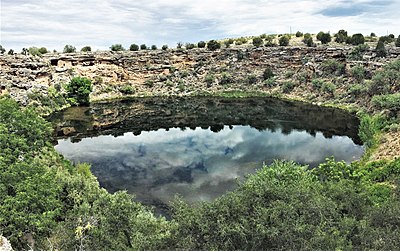34°38′57″N 111°45′08″W / 34.64917°N 111.75222°W



Montezuma Well (Yavapai: ʼHakthkyayva), a detached unit of Montezuma Castle National Monument,[1] is a natural limestone sinkhole near the town of Lake Montezuma, Arizona, through which some 1,500,000 US gallons (5,700,000 L; 1,200,000 imp gal) of water emerge each day from an underground spring. It is located about 11 miles (18 km) northeast of Montezuma Castle.
The "well" measures 386 feet (118 m) in diameter from rim to rim and contains a near-constant volume of spring water even in times of severe drought. The water is highly carbonated and contains high levels of arsenic. At least five endemic species, the most of any spring in the southwestern United States, are found exclusively in Montezuma Well: a diatom, the Montezuma Well springsnail, a water scorpion, the Hyalella montezuma amphipod, and the Motobdella montezuma leech.
Montezuma Well's steady outflow has been used for irrigation since the 8th century. Part of a prehistoric irrigation ditch is preserved near the park's picnic ground, and portions of the ditch's original route are still in use today.
As with Montezuma Castle, the label "Montezuma" is a misnomer: the Aztec emperor Montezuma had no connection to the site or the early indigenous peoples that occupied the area.
